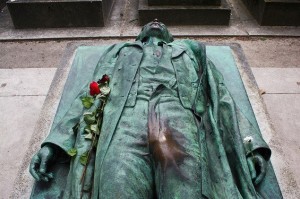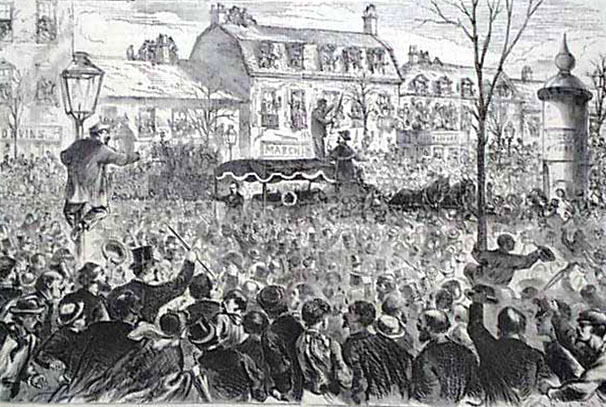Scandal in the Graveyard – L’Affaire Victor Noir.
Andy Royston tells the story of the most scandalous gravestone in Paris and the story of Victor Noir.
After having outraged each of my relations, you insult me with the pen of one of your menials. My turn had to come. I therefore ask you whether your inkpot is guaranteed by your breast… I live, not in a palace, but at 59, rue d’Auteuil. I promise to you that if you present yourself, you will not be told that I left. Prince Pierre Napoléon Bonaparte
 In life Victor Noir (pen name of journalist Yvan Salmon) hadn’t been anyone special. He wasn’t much of a revolutionary either in action or through his writing, but just a chap who found himself in the wrong place at the wrong time, and confronted by the wrong person in the wrong mood.
In life Victor Noir (pen name of journalist Yvan Salmon) hadn’t been anyone special. He wasn’t much of a revolutionary either in action or through his writing, but just a chap who found himself in the wrong place at the wrong time, and confronted by the wrong person in the wrong mood.
He was shot dead during a doorstep confrontation with a pompous cousin of Emperor Napoleon III in the late 1860’s, whilst in the process of arranging a duel. The background to the shooting seemed quite innocuous, yet it sparked a process of events that came close to toppling the ruling regime and saw Noir emerge as a revolutionary symbol.
It all started with a series of letters and columns in two Corsican newspapers. Bonaparte had a letter published in L’Avenir de la Corse, ranting against the staff of the republican La Revanche, calling them cowards and traitors. The editor and publisher of the latter took offense and things quickly got personal. The editor of Revanche, Paschal Grousset, demanded a duel.
He appointed two of his employees Victor Noir and Ulrich de Fonvielle as his seconds, and on January 10, 1870 sent them to Bonaparte’s home to fix terms. Both were said to have been armed, Noir with a sword-cane and de Fonvielle with a revolver.
Bonaparte it seems was furious that the code duello wasn’t being followed and that he was having to deal with menials of the papers editor, rather than its publisher with whom he had his biggest quarrel. By custom, Grousset’s seconds should have dealt with Pierre Napoleon’s own seconds, rather than approaching him directly. After the even the details were disputed, Bonaparte claiming Noir assaulted him. In any case, he shot the young newspaper man dead.
The death of a journalist at the hands of a member of the Imperial family was always going to be big news, and over 100,000 attended a riotous funeral in Noir’s home town, Neuilly. Victor became a cause celeb very quickly and no republican candidate could take a stand without adding the slogan “Il a été au convoi de Victor Noir”.
The acquittal of Bonaparte later in the years fired up the populace even more, and sparked riots and disturbances across Paris. The jury had heard Noir portrayed as a thug who assisted various republican writers to go around and beat up opponents or people they disliked with impunity. Medical evidence showed that Noir, far from just slapping Prince Pierre, hit such a blow on his cheek as to cause it to swell.
Père Lachaise Cemetery
Nous aurons des lits pleins d’odeurs légères,
Des divans profonds comme des tombeaux,
Et d’étranges fleurs sur des étagères,
Ecloses pour nous sous des cieux plus beaux. Charles Baudelaire La Mort des Amants
The family plan had been to bury Noir in the local cemetery, but the people – agitated by firebrand activist Louis Auguste Blanqui – demanded that he be taken on a triumphant procession through Paris and laid to rest at the city’s Père Lachaise cemetery. The family’s will prevailed, however in 1891, when the Third Republic came to power there was a move to create a new monument to his martyrdom in Pere-Lachaise cemetery – sculpted by Dalou, a brilliant virtuoso sculptor who had recently completed major civic commissions.
Jules Dalou decided to cast Victor Noir in a realistic style as though he had just fallen on the street, dropping his hat beside him. He was now a romantic, heroic figure quite unlike how he had been in real life.
Dalou, though, left a legend in the making, and soon Victor’s tomb became not just a revolutionary symbol, but a fertility symbol too.
 On visiting his gravestone in the cemetary’s 92nd division, much of his statue is the familiar verdigris of oxidized bronze you would expect from a monument dating from 1891. However, the lips and the nose are unaccountably shiny from being regularly caressed and kissed. The legions of women who descend upon his tombstone have more than Victor’s memory in mind when they stop by. As is clear by the, um, french polishing, there’s something rather carnal going on…
On visiting his gravestone in the cemetary’s 92nd division, much of his statue is the familiar verdigris of oxidized bronze you would expect from a monument dating from 1891. However, the lips and the nose are unaccountably shiny from being regularly caressed and kissed. The legions of women who descend upon his tombstone have more than Victor’s memory in mind when they stop by. As is clear by the, um, french polishing, there’s something rather carnal going on…
The story goes that Parisian women intent on becoming pregnant would visit Victor, kiss his cold bronze lips and give him a pre-coital rub. The list of ailments that Victor could cure extended over time to falling in love, being married within a year and having an idyllic sex life.
Briefly the cemetery management had had enough and placed a fence around the grave, with a sign that warned against frottements indécents, but well known Paris TV reporter Peri Cochin led a tongue-in-cheek protest, and the fence soon came down.
The legend also has a promise attached – satisfied visitors must place a flower in to his hat or hand to thank him for his time.






